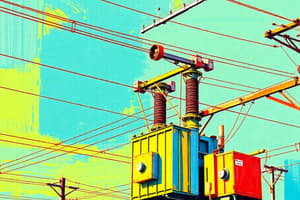Podcast
Questions and Answers
Which of the following is a key difference between the ATX and MicroATX form factors?
Which of the following is a key difference between the ATX and MicroATX form factors?
- MicroATX motherboards use fewer expansion slots than ATX motherboards. (correct)
- ATX motherboards require a higher wattage power supply than MicroATX motherboards.
- ATX motherboards are always larger than MicroATX motherboards.
- MicroATX motherboards use a different type of processor socket than ATX motherboards.
Which of the following connector types is primarily used to provide additional power to modern CPUs?
Which of the following connector types is primarily used to provide additional power to modern CPUs?
- 20-pin P1 Connector
- 6-pin and 8-pin PCIe Connectors
- 24-pin or 20+4-pin P1 Connector
- 4-pin and 8-pin Auxiliary Connectors (correct)
What is the primary function of a grounding wire in a computer system?
What is the primary function of a grounding wire in a computer system?
- To regulate the voltage supplied to components.
- To increase the efficiency of electrical circuits.
- To prevent the accumulation of static electricity on components.
- To provide a path for electricity to flow to the earth in the event of a short circuit. (correct)
What is the purpose of a rectifier in a power supply unit?
What is the purpose of a rectifier in a power supply unit?
Which of the following components typically draws the most power in a computer system?
Which of the following components typically draws the most power in a computer system?
Which of the following is NOT a safe practice when working inside a computer case?
Which of the following is NOT a safe practice when working inside a computer case?
Which of the following is a common cause of overheating in computer components?
Which of the following is a common cause of overheating in computer components?
Which of the following power supply connectors is typically used to power a hard drive?
Which of the following power supply connectors is typically used to power a hard drive?
Which of the following is a valid reason why a power supply might fail to start a computer?
Which of the following is a valid reason why a power supply might fail to start a computer?
Which of the following power connectors is commonly used for connecting to a power supply's motherboard?
Which of the following power connectors is commonly used for connecting to a power supply's motherboard?
What are the two main form factors for cases, power supplies, and motherboards?
What are the two main form factors for cases, power supplies, and motherboards?
Which of the following standards is used by hard drives to interface with a motherboard?
Which of the following standards is used by hard drives to interface with a motherboard?
What type of electrical current do microcomputers require?
What type of electrical current do microcomputers require?
Which item is critical for preventing electrostatic discharge (ESD) when handling computer components?
Which item is critical for preventing electrostatic discharge (ESD) when handling computer components?
What should always be checked to avoid trip hazards with cables?
What should always be checked to avoid trip hazards with cables?
What is the role of a power supply tester?
What is the role of a power supply tester?
What type of ROM chips can be overwritten?
What type of ROM chips can be overwritten?
Which of the following is an essential way to lift heavy objects safely?
Which of the following is an essential way to lift heavy objects safely?
What should be included with chemical cleaning solutions to guide proper handling?
What should be included with chemical cleaning solutions to guide proper handling?
What is a potential warning sign that an electronic device may be unsafe to use?
What is a potential warning sign that an electronic device may be unsafe to use?
Which method should NOT be used when working with power supplies and CRT monitors containing capacitors?
Which method should NOT be used when working with power supplies and CRT monitors containing capacitors?
Which class of fire extinguisher is suitable for putting out electrical fires?
Which class of fire extinguisher is suitable for putting out electrical fires?
What type of failure can result from electrostatic discharge (ESD)?
What type of failure can result from electrostatic discharge (ESD)?
What should be done before passing a circuit board to another person to avoid ESD?
What should be done before passing a circuit board to another person to avoid ESD?
How can you minimize ESD when working on sensitive computer components?
How can you minimize ESD when working on sensitive computer components?
Which of the following tools is considered essential for a PC repair technician?
Which of the following tools is considered essential for a PC repair technician?
What is the function of post diagnostic cards?
What is the function of post diagnostic cards?
What is an incorrect practice when using grounding methods for ESD safety?
What is an incorrect practice when using grounding methods for ESD safety?
Which rule helps to ensure safety during the handling of electronic components?
Which rule helps to ensure safety during the handling of electronic components?
Flashcards are hidden until you start studying
Study Notes
Here are the study notes in markdown format:
Potentials Dangers of Electrical Shock and Burns
- Power cord is frayed or damaged
- Water or other liquid is spilled near electronic devices
- Device has been dropped or physically damaged
- Strong electronics odor is present
- Power supply or fans make a whining noise
- Smoke is observed or case feels unusually warm
Protecting Yourself Against Electrical Shock and Burns
- Ground yourself with an anti-static grounding bracelet when working on sensitive low-voltage equipment
- Do not ground yourself when working with power supplies, printers, and CRT monitors that contain capacitors
- Never use water to put out a fire (water is a conductor)
- Use a fire extinguisher rated to put out electrical fires
- Fire extinguisher ratings: Class A (wood, paper, or other combustibles), Class B (liquids), Class C (electrical)
Protecting Equipment Against Static Electricity or ESD
- Electrostatic discharge (ESD) occurs when two objects with dissimilar electrical charges touch
- ESD can cause two types of damage: catastrophic failure (destroys the component) and upset failure (damages the component so it does not work well)
- Protect against ESD by grounding yourself with:
- Ground bracelet (ESD strap, anti-static wrist strap, or ESD bracelet)
- Ground mats (ESD mats)
- Static shielding bags (anti-static bags)
- Anti-static gloves (ESD gloves)
Rules for Protecting Equipment Against ESD
- Rule 1: Ground yourself and touch the other person before passing a circuit board or other component
- Rule 2: Leave components inside anti-static bags until ready to use them
- Rule 3: Work on hard floors, not carpet
- Rule 4: Don't work on a computer in a cold and dry atmosphere
- Rule 5: Remove packing tape and cellophane from around work area (materials that attract ESD)
- Rule 6: Keep components away from hair and clothing
Tools Used by a PC Repair Technician
- Essential tools:
- Ground bracelet, ground mat, anti-static gloves
- Flat-head screwdriver
- Phillips-head or cross-head screwdriver
- Torx screwdriver set (size T15)
- Insulated tweezers
- Extractor
- OS recovery CD or DVD
- Many other non-essential tools exist
- Use a toolbox
What's Inside a Computer Case
- Computer case: holds power supply, motherboard, processor, memory modules, expansion cards, hard drive, optical drive, and other drives
- Motherboard: largest and most important circuit board
- Processor (CPU): processes most of the data and instructions for the entire system
- Expansion cards (adapter cards): provide more ports than those provided by the motherboard
- Memory modules (RAM): temporary storage for data and instructions as they are being processed by the CPU
- Hard drives and other drives: permanent storage used to hold data and programs
Form Factors Used by Computer Cases, Power Supplies, and Motherboards
- Form factors: standards that describe the size, shape, screw hole positions, and major features of computer cases, power supplies, and motherboards
- Two form factors used by most desktop and tower computer cases and power supplies: ATX and Mini-ATX
Drives, Their Cables, and Connectors
- Hard drives: two standards - Serial ATA (SATA) and Parallel ATA (PATA)
- Floppy drive: uses a 34-pin twisted cable
- Other drives: optical drive, tape drive
Protecting Yourself and Equipment Against Electrical Dangers
- Important to understand electricity and how to protect yourself and equipment against it
- Must learn to prevent getting shocked or damaging a component
Measures and Properties of Electricity
- Alternating current (AC): oscillates between negative and positive voltage
- Direct current (DC): travels in one direction
- Rectifier: a device that converts AC to DC
- Inverter: a device that converts DC to AC
- Transformer: devices that changes the ratio of voltage to current
Tools and Safety Precautions
- Power supply tester: measures output of each power supply connector
- Multimeter: measures several characteristics of electricity in a variety of devices
- Loopback plug: used to test a port in a computer or other device to make sure the port is working
- Cleaning solutions and pads: use with care and follow Material Safety Data Sheet (MSDS) instructions
- Managing cables: keep cables in a safe place and use cable or cord covers if necessary
- Lifting heavy objects: follow guidelines to avoid back injury
Studying That Suits You
Use AI to generate personalized quizzes and flashcards to suit your learning preferences.




